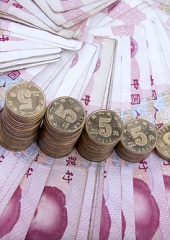The Hidden Advantage (and Disadvantage) of Chinese Subsidies
Will Chinese subsidies end up killing China’s competition?
March 6, 2014

Delegates arrived at the Great Hall of the People to attend sessions of National People’s Congress and Chinese People’s Political Consultative Conference in Beijing, China, on Tuesday, March 4, 2014.
Usha and George Haley
– Advantages and Disadvantages
– Zombies and Glass Houses
Reform advocates are looking to this week’s meeting of China’s ceremonial legislature, the National People’s Congress, for signs the ruling party is ready to tackle more ambitious and politically thorny changes.
“China provides easy access to capital and the United States does not.” That’s essentially how an executive of Evergreen Solar, then the third-largest U.S. solar manufacturer, highlighted his reasons for moving production from Boston to Wuhan in
2011. He banked the move to China on the promise of the provincial government’s support.
The hidden advantage of China, he elaborated, lay in abundant government subsidies, not in cheap labor. And indeed, labor costs are only a tiny factor in the capital-intensive solar-panel sector in which he worked.
Between 2008 and 2014, China’s solar industry grew tenfold. It now accounts for about 80% of the world’s production capacity. This dramatic shift occurred on the back of massive subsidies — such as loans that never had to be repaid, discounted energy, raw materials and land.
Simultaneously, a steadily increasing supply of Chinese solar panels propelled worldwide prices downward by 75%. That, in turn, causes firms’ bankruptcies and factory shutdowns in the United States and European Union.
The subsidized leap forward
For the past six years, we have sifted through murky statistics to explore one storyline – albeit a telltale one: How does China manage to move over the space of just a couple of years, in one capital-intensive industry after another and with insignificant labor-cost advantage, from bit player and net importer to the largest manufacturer and the largest exporter in the world?
Along that road, we witnessed how many industrialized countries became primarily exporters of commodities and, in effect, merely scrap, to fuel China’s expansion. As with solar panels, China’s scale of production also resulted in companies’ anointing mature technologies as dominant, thereby hindering future technological development in these industries.
As we saw, the hidden advantages of Chinese subsidies came with associated disadvantages for efficient producers worldwide, for analysts who could not ascertain the true worth of
companies’ operations, and for consumers who unwittingly forfeited the advantages of technological innovation.
But this is not another story of Chinese triumph, in which the rest of the world is victimized while China stands tall. In fact, China is also a victim in this process – only this time it is self- inflicted.
A global chess game
The widespread effects of the sudden shifts of production to China on national competitive advantage are among the most important, yet underexplored economic changes since the 18th century.
From 2000 to the present day, the value of Chinese exports more than quadrupled. In 2009, China surpassed Germany to become the world’s largest exporter.
In 2010, China became the second-largest producer in the world, overtaking Japan. In 2010, Chinese foreign-exchange reserves became the largest in the world. In 2012, China overtook the United States to become the world’s biggest trading nation as measured by the sum of exports and imports of goods.
Capital-intensive goods such as solar panels, for which China enjoyed no comparative advantage just a decade ago, have fueled these tectonic changes.
Karel De Gucht, the European Union’s trade commissioner, has linked China’s exports to its pervasive industrial policy. As he pointed out, to discover what the next wave of subsidized industries will be, “you read the last five-year plan.”
Over-performing
We studied the evolution of these capital-intensive industries that Beijing pronounced as strategically important. In these industries, labor approximated between 2-7% of the costs of production. Imported raw materials and energy, for which China paid market prices, comprise most of the costs of production.
Contrary to the Western image of industrial China being dominated by gigantic SOEs, it is actually small companies using old technologies with no economies of scale or scope who constitute the bulk of producers in these industries.
And yet, the Chinese miraculously manage to sell their products for a third less than those from the United States or European Union.
Our research found that subsidies from central and provincial governments in these industries appeared to exceed 30% of industrial output and growing.
Economic theories have mostly portrayed subsidies as distortions in the sense that they redistribute and reallocate resources according to non-market criteria and result in economically inefficient allocations of resources.
Unless in special circumstances (such as with infant industries), economists have generally ignored the view that subsidies may contribute to the subsidizing country’s comparative advantage in the global economy.
How China really thinks
Economic considerations not withstanding, in China, subsidies form “conceptions of control.” They are important ways in which Chinese businesses and governments produce, stabilize and create common understandings of their markets.
Flows of “subterranean” subsidies reflect interactions and struggles between critical Chinese actors that influence, and depend on, each other. They include central and provincial governments as well as state-owned enterprises. And, counter to Western images of Chinese uniformity, all of these players have different resources, interests and market visions.
The Chinese state has willingly paid the price of economic inefficiency. It does so to accomplish political, social, economic and diplomatic goals that assume greater importance for Chinese policymakers. This means that, far beyond usual economic considerations, subsidies have immediacy that transcends the purely theoretical.
Solar showed the way
Our research over the past 6 years showed that the solar story has resurfaced across other global industries including steel, glass, paper and auto parts.
In all these capital-intensive industries with minuscule labor costs, China rose from a net importer to among the largest producers and exporters in the world.
However, meager information has stifled studies of Chinese subsidies. The Chinese government does not report subsidies to domestic industrial companies, many of whom have become major players in their global industries.
China’s modern global rise began almost four decades ago in
1976, when Deng Xiaoping took over as China’s paramount leader after Mao Zedong. In December 2001, in line with Deng’s reforms, and after 15 years of diplomatic negotiations, China became a member of the World Trade Organization.
Subsequently, China’s economic growth rapidly transcended its historical base of labor-intensive to capital-intensive industries. Currently, China’s exports have significantly more sophistication, and contain more high-tech goods, than what one would assume based on pure comparative-advantage arguments.
Promotion and protection
China’s industrial policies of “promotion and protection” shape its industrial structure and exports. Since 2001, subsidies have financed about 20% of production-capacity expansion in China.
This wave was fueled by large, ever-increasing streams of raw materials from the rest of the world, including from industrialized countries. The latter, in turn, became the customers for China’s bounty of magically cheap products.
It seems like a charmed complementary circle – even if one where long-standing considerations of who’s in charge of the game get toppled. But appearances can be deceiving.
Consider the perspective of provincial policymakers. They saw that subsidies could speedily erect industries that provided employment at their home base and also decreased the possibilities of social unrest.
Under these tempting circumstances, it is no wonder that like the title character in “The Sorcerer’s Apprentice”, the different levels of Chinese government have been unable or unwilling to turn off the spigot of subsidies.
A closer look at who wins (or loses)
Our findings on Chinese subsidies contradict the widespread belief that China’s enormous success as an exporting nation primarily derives from low labor costs and deliberate currency undervaluation.
Economists have generally argued that these subsidies hurt China, but help consumers around the world by offering products at cheap prices. Yet, our research identifies Chinese production as highly inefficient: Without subsidies, many of these Chinese firms would be bankrupt.
The unintended consequences of moving most production to China in these subsidized, capital-intensive industries will take years to realign, if at all, with basic principles of comparative advantage, contributing to losses in global welfare.
The Chinese industries that dominate world production are also highly fragmented. Mostly, they are populated by small and medium-sized companies using mature (if not old) technologies. Beijing periodically releases statements on planned industrial consolidation.
Enter free trade
Free trade may lead to suboptimal outcomes, while protectionism can increase national income by raising firms’ profitability and efficiencies in imperfect markets.
However, the usual Western response – blocking subsidized Chinese products – often appears as a game of whack-a-mole. In 2012, the United States slapped tariffs of up to 255% on Chinese solar-panel exporters for offering illegal subsidies and dumping. Sounds like a powerful reaction, but is it an effective one?
One Chinese reaction to beat the tariffs involved moving some production to Taiwan. In December 2013, SolarWorld that had filed the 2012 petition filed another with the U.S. International Trade Commission to close this loophole and this is being investigated.
In June 2013, the European Commission threatened to impose tariffs on Chinese solar panels. But the European body withdrew that measure when China threatened retaliation and Germany, the sole European country enjoying a significant trade surplus with China, questioned the Commission’s case.
Eventually, the two sides reached a settlement stipulating a minimum price for Chinese solar panels. In November 2013, the Commission imposed tariffs of up to 42.1% on Chinese solar- glass exporters.
Policy tangle
This tangled situation illustrates difficulties of identifying and punishing subsidies in global industries. Complex supply chains spawn myriad, often conflicting, trading interests. Still, they don’t seem to amount to much when industrial policies appear to be the rule, not the exception, as in China.
The policy tangle becomes even more knotty as China’s central and provincial government subsidies often have contradictory goals in global trade. The former wants to move the country’s industry to higher value-added production. The latter are mostly devoted to maintaining provincial employment and obviating social unrest.
In the global economy, uncoordinated Chinese governmental subsidies have led to a new normal of boom-and-bust cycles. These affect a range of products, thereby increasing supply- chain vulnerabilities.
Global boom-bust
Meanwhile, in industry after industry, inventories pile up as Chinese production exceeds global demand, prices plummet, shortages ensue, prices spike, Chinese production ramps up – and then the cycle repeats.
Such developments call for greater surveillance and informed negotiations. In order for this game of guts and chicken to be more productive, one would have to include companies, federal- government agencies, security and exchange commissions, as well as Chinese central and provincial agencies through both trade blocs and bilaterally.
It is hard to imagine that the world economy will soon tackle such a complex undertaking.
Meanwhile, Chinese government subsidies will continue. In some ways, although hardly sustainable ones, they contribute substantially to recipient companies’ competitiveness, while increasing uncertainty in global markets.
Takeaways
How did China manage to move from bit player to the largest manufacturer and the largest exporter in the world?
The sudden production shift to China is among the most important economic changes since the 18th century.
China’s small firms using old technologies without economies of scale constitute the bulk of industrial producers.
Chinese industrial subsidies from central and provincial governments exceed 30% of industrial output.
The West imagines uniformity, but Chinese firms and levels of government all have differing market visions.
The Chinese state has willingly paid the price of economic inefficiency to meet political, social and economic goals.
Thanks to subsidies, China managed to shift quickly from its base of labor-intensive to capital-intensive industries.
Chinese subsidies make recipient companies’ competitive, while increasing uncertainty in global markets.


